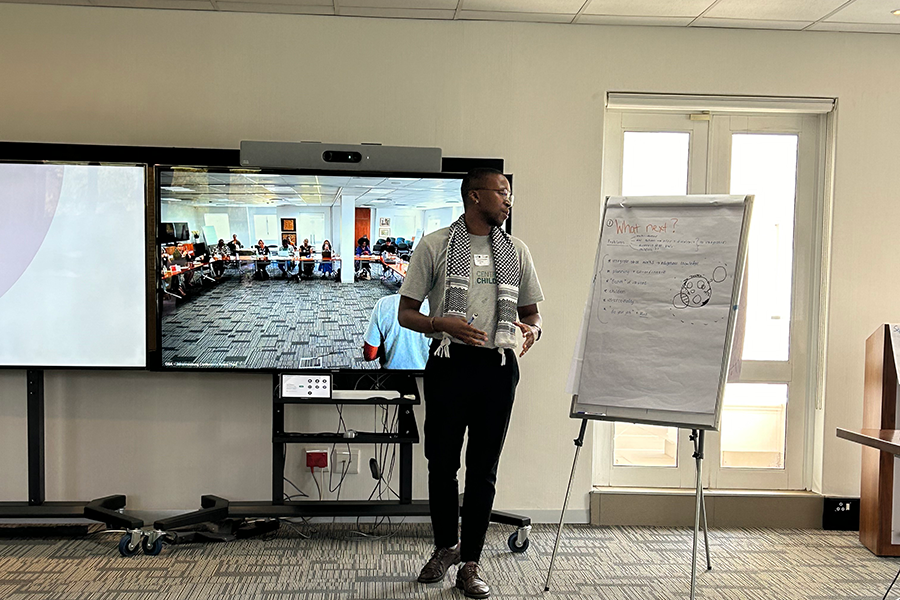Intersections of violence against women and children

Experiencing and witnessing violence during childhood can trigger an intergenerational cycle of violence leading to an increased risk of boys developing violent behaviour and perpetrating partner abuse, as well as an increased risk of girls becoming victims of intimate partner violence. Experiences of intimate partner violence in turn increase the risk of women using corporal punishment against their own children.
This blog aims to deepen the understanding of the intersections between violence against women (VAW) and violence against children (VAC) in order to facilitate shared learning between the sectors of VAW and VAC in South Africa.
On the 7th and 8th of April 2025, practitioners and stakeholders from across South Africa gathered in Johannesburg for a workshop to engage on the new publication titled Preventing Violence Against Women and Violence Against Children: A toolkit for practitioners, authored by Aislinn Delany, Shanaaz Mathews, and Lizette Berry. Hosted by the Department of Paediatrics and Child Health, UCT, the two-day workshop focused on supporting practitioners to deepen their understanding of violence prevention programming to shape their ongoing efforts to tackle violence against women (VAW) and children (VAC).

On 30 November 2023, stakeholders convened at The Ford Foundation in Melrose Estate, Johannesburg, for a pivotal roundtable dialogue on the complex intersections of violence against women (VAW) and violence against children (VAC). This gathering of eminent voices within the women and children's sectors presented a significant learning opportunity in the ongoing pursuit of sharing knowledge and experiences across the two sectors.
28 November 2022: At the intersection of childhood and womanhood, adolescent girls are falling through the cracks of violence prevention
Breaking the cycle of violence against children and women requires evidence-based investments and strategies and interventions across sectors, communities, and societies, including at different levels of government, to specifically address the risks that adolescent girls face.
27 October 2022: Violence against adolescents: prevention must cross the divide between children and women
Vulnerability to violence is high in adolescence and poses a considerable threat to adolescents’ safety and wellbeing over the course of their lives. Opportunities for greater collaboration include preparing service providers to tackle multiple forms of violence, better coordination between services, school-based strategies, parenting programmes, and a common research agenda.
22 June 2022: Child Protection Week: Tend to our children’s cry for help
UCT News shines a spotlight on a recent study led by a team of CI researchers – Professor Shanaaz Mathews, Dr Neziswa Titi and Lucy Jamieson. The study is titled “Closing the gaps in services that respond to violence against women and children”. Dr Neziswa Titi says all sectors of society have a role to play to address the scourge of sexual and gender-based violence.
24 April 2022: Gender-transformative approaches are key to programming aimed at reducing violence against women and children
The Children’s Institute (CI) and Sonke Gender Justice co-hosted a two-day capacity building workshop, bringing together several organisations from the women and children’s sectors. This blog summarises how It aimed to explore gender-transformative programming and how this can be considered within the various organisations.
1 December 2021: Gender-based violence and Covid-19: A collision of pandemics
Interviews with women, men and young people in communities across the Western Cape a year into the pandemic provide insight into some issues that require urgent attention. Those interviewed confirmed that Covid-19 has had a devastating effect on their lives, and has exacerbated the social norms that drive gendered violence in the home and communities.
23 November 2021: Preventing violence starts with changing discriminatory gender norms
A child protection specialist discusses what can be done on the ground to root out harmful gender norms that perpetuate violence against women and girls: “Only by working with parents – especially fathers – alongside educators and young people, can we begin to prevent violence before it starts.”
6 June 2021: Early intervention is best way to break cycle of child, gender violence
Experiencing violence as well as exposure to violence in the home is especially damaging during the first 1,000 days of a child’s life. We have to ask ourselves whether drawing the country’s attention once a year to the need to stop violence against children is enough when we are acutely aware of the ongoing high levels of violence against children.
7 December 2020: Ending violence against women and children requires a shift in our thinking and practices
As we reach the end of the 16 days of activism of no violence against women and children campaign, we have to ask ourselves how do we continue to actively play a part in the fight to end violence against women and children? To win this fight, we need to reflect on how we have been complicit in our practices and attitudes to maintaining the perpetuation of violence against women and children.
29 November 2020: End this heartbreaking cycle of violence against children
Evidence is clear that experiencing violence during childhood can trigger an intergenerational cycle of violence. Studies from SA and elsewhere show that witnessing abuse of their mother increases boys’ risk of developing violent behaviour and abusing a partner in adulthood; while for girls, experiences of abuse during childhood increase the risk of them becoming a victim of intimate partner violence.
26 May 2020: Our Covid-19 strategy must include measures to reduce violence against women and children
The Covid-19 pandemic is having far reaching and devasting human, social and economic effects across the globe. Many countries have imposed lockdown measures, confining people to their homes to curb the spread of the virus and reduce the loss of lives. Potentially, creating the perfect storm for the surge of another pandemic – violence against women and children.
28 November 2018: The link between violence against women and children matters. Here’s why
Nearly half of women across South Africa are subjected to violence by an intimate partner. This in turn negatively affects about one in four children. A child who is exposed to violence in the home also risks being abused and will, quite reasonably, fear for their own safety. There’s an increasing global recognition that violence against women and children often occur together in homes, and are driven by the same factors.











